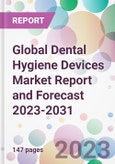Introduction
Dental hygiene devices play a crucial role in maintaining oral health by enabling effective plaque removal, gum care, and overall dental hygiene. These devices are designed to be used at home as part of daily oral care routines or by dental professionals during dental procedures. They aid in the prevention of dental diseases such as tooth decay, gum disease, and bad breath.Key Trends in the Dental Hygiene Devices Market
Some of the key trends in the market are:- Technological Advancements: Dental hygiene devices are witnessing significant technological advancements. These include the integration of advanced features such as oscillating or rotating brush heads, pressure sensors, timers, and Bluetooth connectivity for enhanced functionality and user experience. Technological innovations aim to improve the efficiency of plaque removal, provide personalized oral care guidance, and enable better tracking and monitoring of oral health
- Increasing Focus on Oral Health Awareness: There is a growing emphasis on oral health awareness and preventive dental care. This trend has led to increased adoption of dental hygiene devices by individuals as they become more conscious of the importance of maintaining good oral hygiene. Dental professionals also play a crucial role in educating patients about the benefits of using dental hygiene devices as part of their oral care routine
- Rising Demand for Homecare Dental Devices: With the increasing preference for homecare and self-management of oral health, there is a rising demand for dental hygiene devices that can be used at home. Consumers are looking for convenient, easy-to-use, and effective devices that can complement their regular brushing and flossing routine. This trend is driven by the desire for proactive oral care and the convenience of maintaining oral health in the comfort of one's own home
Dental Hygiene Devices Market Segmentations
Market Breakup by Product
- Dental Handpieces
- Dental Burs
- Dental Lasers
- Dental Scalers
- Others
Market Breakup by Age Group
- 0-8 Years Old
- 9-21 Years Old
- 22-34 Years Old
- 35-44 Years Old
- 45-64 Years Old
- 65-74 Years Old
- >74 Years Old
Market Breakup by End User
- Hospitals
- Specialty Clinics
- Homecare
Market Breakup by Region
North America
- United States of America
- Canada
Europe
- United Kingdom
- Germany
- France
- Italy
- Others
Asia Pacific
- China
- Japan
- India
- ASEAN
- Australia
- Others
Latin America
- Brazil
- Argentina
- Mexico
- Others
Middle East and Africa
- Saudi Arabia
- United Arab Emirates
- Nigeria
- South Africa
- Others
Dental Hygiene Devices Market Scenario
The market for dental hygiene devices is a vital component of the oral care industry, catering to the growing demand for effective and convenient oral hygiene solutions. Dental hygiene devices are widely used by individuals at home as well as by dental professionals in clinics, contributing to the maintenance of optimal oral health and prevention of dental diseases.The market is driven by several factors, including increasing oral health awareness among consumers, rising prevalence of dental diseases, and a growing emphasis on preventive dental care. As individuals become more conscious of the importance of maintaining good oral hygiene, they are seeking reliable and convenient dental hygiene devices to supplement their brushing and flossing routines. This has led to a rise in demand for products such as electric toothbrushes, water flossers, interdental cleaners, and tongue cleaners.
Technological advancements are playing a significant role in shaping the market. Dental hygiene devices are incorporating innovative features such as oscillating or rotating brush heads, pressure sensors, timers, and smart connectivity options. These advancements enhance the effectiveness and convenience of oral care routines, providing users with real-time feedback, personalized recommendations, and improved tracking of their oral health.
Dental Hygiene Devices Market: Competitor Landscape
The key features of the market report include patent analysis, grants analysis, clinical trials analysis, funding and investment analysis, partnerships, and collaborations analysis by the leading key players. The major companies in the market are as follows:- BIOLASE Inc
- Envista Holding Corporation Ltd
- Dentsply Sirona Inc
- Nikanishi Inc
- Brasseler USA
- Unilever Plc
- 3M Company
- Johnson & Johnson
- The Procter & Gamble Company
- Ultradent Products
- GlaxoSmithKline plc
- Koninklijke Philips N.V
- Colgate-Palmolive Company
- Dabur India
Table of Contents
Companies Mentioned
- BIOLASE Inc.
- Envista Holding Corporation Ltd.
- Dentsply Sirona Inc.
- Nikanishi Inc.
- Brasseler USA
- Unilever Plc.
- 3M Company
- Johnson & Johnson
- The Procter & Gamble Company
- Ultradent Products
- GlaxoSmithKline plc.
- Koninklijke Philips N.V.
- Colgate-Palmolive Company.
- Dabur India
Methodology

LOADING...
Table Information
| Report Attribute | Details |
|---|---|
| No. of Pages | 147 |
| Published | May 2023 |
| Forecast Period | 2023 - 2031 |
| Estimated Market Value ( USD | $ 6.8 Billion |
| Forecasted Market Value ( USD | $ 9.6 Billion |
| Compound Annual Growth Rate | 4.5% |
| Regions Covered | Global |
| No. of Companies Mentioned | 14 |









